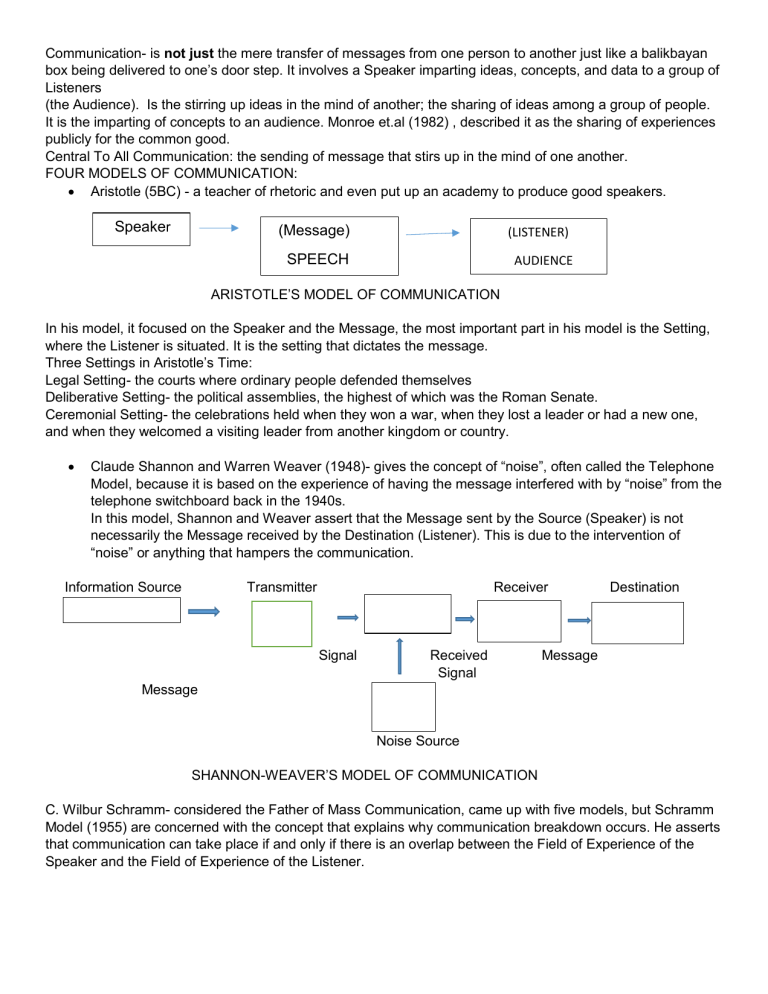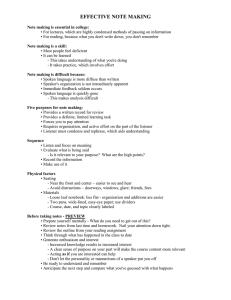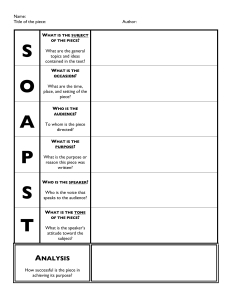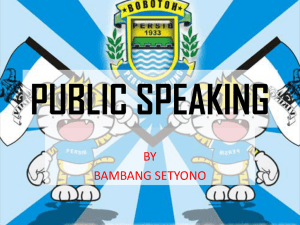
Communication- is not just the mere transfer of messages from one person to another just like a balikbayan box being delivered to one’s door step. It involves a Speaker imparting ideas, concepts, and data to a group of Listeners (the Audience). Is the stirring up ideas in the mind of another; the sharing of ideas among a group of people. It is the imparting of concepts to an audience. Monroe et.al (1982) , described it as the sharing of experiences publicly for the common good. Central To All Communication: the sending of message that stirs up in the mind of one another. FOUR MODELS OF COMMUNICATION: Aristotle (5BC) - a teacher of rhetoric and even put up an academy to produce good speakers. Speaker (Message) (LISTENER) SPEECH AUDIENCE ARISTOTLE’S MODEL OF COMMUNICATION In his model, it focused on the Speaker and the Message, the most important part in his model is the Setting, where the Listener is situated. It is the setting that dictates the message. Three Settings in Aristotle’s Time: Legal Setting- the courts where ordinary people defended themselves Deliberative Setting- the political assemblies, the highest of which was the Roman Senate. Ceremonial Setting- the celebrations held when they won a war, when they lost a leader or had a new one, and when they welcomed a visiting leader from another kingdom or country. Claude Shannon and Warren Weaver (1948)- gives the concept of “noise”, often called the Telephone Model, because it is based on the experience of having the message interfered with by “noise” from the telephone switchboard back in the 1940s. In this model, Shannon and Weaver assert that the Message sent by the Source (Speaker) is not necessarily the Message received by the Destination (Listener). This is due to the intervention of “noise” or anything that hampers the communication. Information Source Transmitter Receiver Signal Received Signal Destination Message Message Noise Source SHANNON-WEAVER’S MODEL OF COMMUNICATION C. Wilbur Schramm- considered the Father of Mass Communication, came up with five models, but Schramm Model (1955) are concerned with the concept that explains why communication breakdown occurs. He asserts that communication can take place if and only if there is an overlap between the Field of Experience of the Speaker and the Field of Experience of the Listener. Field of Experience Destination Signal Source Encoder encoder Encod Encoder SCHRAMM’S MODEL OF COMMUNICATION EEEE FIELD OF EXPERIENCE What is the Field of Experience? It is everything that makes a person unique-everything he/she has never learned, watched, seen, heard, read, and studied. In other words it is everything a person has ever experienced or not experienced, done or not done, or one that is practically happened in his/her life. D. The fourth model is that of Eugene White (1960), who tells us that communication is circular and continuous, without a beginning or end. And made a cyclical mode, in which he points out that although we can assume that communication begins with thinking, communication can actually be observed from any point in the circle. Expressing Symbolizing Transmitting Transmitting Thinking Monitoring Feedback Decoding Receiving WHITE’S MODEL OF COMMUNICATION Eugene White contributed the concept of Feedback to the field of communication. Feedback is the perception by the Speaker about the Response of the Listener. The Speaker can only receive Feedback, if the Speaker is monitoring the Listener. The Speaker will know what the Listener’s Response is only if he/she is paying attention. The Process of Communication Communication comes about when the Message is imparted as Information, and at the minimum, two persons are involved in the process: one who delivers the Message and one who receives and understands the Message. ELEMENTS OF COMMUNICATION A. The Speaker- chooses his/her purpose , crafts the message accordingly and decides how to deliver it, such as when a President delivers his state of the nation address. B. The Message- what needs to be delivered or imparted to somebody else; this is central to the process because the point of communicating is to say “something”. -The message to be sent is based on why the Speaker wants to say it (to inform or to persuade), what the Speaker wants to say, and how the Speaker wants to say it. C. The Listener-receives the message. It is said that even if the Speaker is great and the message is beautiful, if there is no Listener or the Listener is not paying attention, then communication fails. It is the Listener who makes sense of what is said and reacts to it- by clapping, nodding the head, replying, asking a return question, following the speaker, falling asleep, or walking out. D. Channels- the means by which the Message is sent. There are only five channels: ears, eyes, skin, mouth, and nose. In other words, a message is sent and received via the senses. Of course, messages are first received through the ears by hearing, while gestures and facial expressions are received by the eyes through seeing. The skin, mouth, and nose are not the main pathways for sending a message, but they are still crucial in the imparting and receiving of messages. E. The Response- the only way the speaker knows that the Message has been received. Whether the Listener responds or not, is central to the communication process. The Response is, of course, based on the Interpretation of the Message by the Listener. F. Feedback- the result of monitoring by the Speaker of the Listener’s Response. The Speaker needs to watch out for his Response to know if the Message was effectively imparted or not. Making sure of what the Feedback is, will help the Speaker in continuing with the next Message. G. Noise- any barrier to communication. It could be physical “noise”-actual noise such as loud music or the irritating engine of a motorcyle. H. Communicative Situation- has two components: the physical location and the psychological setting. -The physical location is usually chosen for the purpose it will serve: a classroom that can be used for a meeting, an auditorium which can be transformed into a theater for a play, and the streets that serve as the setting for rallies. -The psychological setting depends on the participants. The classroom is for teaching, but the Parent-Teacher Association (PTA) holds its meeting there; the auditorium for school programs is now the stage for the Drama Clubs production of “Supremo,” the Life of Bonifacio; the streets meant for moving vehicles to traverse is now used by the group One Billion Rising to hold a rally protesting violence against women. Dimensions of Communication -Miscommunication, is brought about by the lack of awareness of the dimensions of communication, especially those influenced by culture and gender. FOUR PAIRS OF DIMENSIONS OF COMMUNICATION: A. Verbal/Nonverbal Dimensions-encompass the use of language, the words chosen (Verbal Dimension) and the facial expressions, and the gestures and bodily movement used ( Nonverbal Dimension). Verbal and Nonverbal Dimensions must be used together to clearly impart the message. B. Oral/Written Dimensions-mean spoken communication (Oral Dimension) and the transcirption of thoughts and ideas (Written Dimension). While the Verbal Dimension talks of the use of language and the choice of words to convey a written Message, the Oral Dimension imparts the Message following the Principles of Delivery. The Written Dimension takes care of putting down the words while the Oral Dimension takes care of putting down the words while the Oral Dimension takes care of delivering those words (although that may not necessarily happen). C. Formal/ Informal Dimensions-speak of the factors that may or may not highlight traditional and conventional communication. -The Formal Dimension usually means the meticulous observation of appropriateness in dress, language and setting, while the Informal Dimension is the opposite. That is, it uses a more casual approach with no regard for the formalities. D. Intentional/Unintentional Dimensions-rely on the fact that the Messages always have a Purpose.There is an intention when people communicate with others. MASS COMMUNICATION Plays an influential role in modern society. A process in which a person, group of people, or an organization sends a message through a large group of anonymous and heterogeneous people and organization. ( this will either the general public or a segment of the general public). CHANNELS OF COMMUNICATION INCLUDE: Broadcast Television Radio Social Media and Print -The sender of the message is usually a Professional Communicator that often represents an organization. Mass Communication is an expensive process; unlike Interpersonal communication, feedback for mass communication is usually slow and indirect. EXAMPLE/TYPE OF MASS COMMUNICATION: -Advertising, consist of communications attempting to include purchasing behavior -Journalism such as News. -Public relations, which is communication intended to influence public opinion on a product or organization. -Politics (For example, campaigning) Communication Arts- explores the knowledge of communication theories. Mass communication studies how people communicate through the use of radio, TV, print, social media, internet. -Communication arts, focuses on how to specifically communicate in any given situation. Mass communication is about media, internet, social media, etc., in other words, the vehicles for widespread communication. -Communication arts could be talking to only 1 person while mass communication is talking to a lot of people at the same time. It is much broader, it studies rhetoric and theory that is applicable to all settings. LANGUAGE AS BEDROCK OF COMMUNICATION ARTS -Human beings need to communicate thoughts and feelings to others of their kind. The messages maybe expressed, or transmitted and received through any of of the perception channels: visual (sight), auditory (hearing), olfactory (smell), gustatory (taste), and tactile (touch). It is in this need, which we share ideas and give rise to language. Thus language is defined as the expression or communication of thoughts and feelings by means of vocal sounds and written symbols, and communication of vocal sounds and written symbols, and the communication of such sounds to which meanings attributed. HOW LANGUAGE IS DEVELOPED? Where Did Language Begin? As you are reading this right now, you are using language to interpret symbols into meaning. In this case, we're using written language to convey meaning. However, the symbols of written language correspond to sounds in spoken language as a way to ''talk'' to people separated by space, or even time. The reason for the corresponding symbol to sound comes from the fact that spoken language is so much older than written language. Early Theories Of the many theories proposed during the 1800s and early 1900s, six theories summarize and simplify the general themes most of them contain, which is why they are still taught in the history of linguistic theory. 1. Bow-Wow: Much as we create words to imitate actual sounds, such as bow-wow for a dog's bark or a-choo 2. 3. 4. 5. 6. for a sneeze, this theory suggests language formed from imitation of sounds which formed into words. Ding-Dong: This theory claims language, words, and individual sounds are connected through nature, such as applying certain sounds more frequently to particular phenomena. The best evidence comes from the number of languages using the sound ''fl'' in words related to speed. Pooh-Pooh: This theory believes we developed language from spontaneous sounds like ''Ouch!'' or ''Ha!''. La-La: This theory thinks language developed out of sounds early humans made while playing and wordless singing. Ta-Ta: The final theory offers that language came from trying to use our mouths and sounds to imitate physical gestures. Yo-He-Ho: If you've ever lifted anything heavy, you might have let out a groan or other kind of sound. This theory claims language came from the sounds we made while doing hard work. Could Several Theories Be Correct? Recent theories for the evolution and migration of early hominids and humans complicate the issue of explaining how language developed. The monogenesis theories also called the Out of Africa theories, and Mother-Tongue theories, posit that humans and other hominids developed in Africa first, then migrated outward to the rest of the world. Linguistically, this also presupposes the existence of an original language that formed in Africa. The polygenesis theories, however, argue that hominids migrated out of Africa at different times and that many early human ancestors may have evolved in places other than Africa. Linguistically, polygenesis argues that whether humans evolved in one place or many, language use rose from multiple places, which may be supported by the wide variety of languages, and language families, in existence today. If polygenesis is correct, language development may have happened in a variety of ways across distance human populations. However, this depends on whether humans migrated out of Africa before developing language, or after. New or Contemporary Theories While theorizing on the origins and development of language stagnated for decades, interest in the origin of language is returning in light of new developments in the archaeological record, animal behavior research, and studies in human biology. Co-Evolution of Humans and Language: This theory notes that the biological requirements to make language possible did not happen at once. These include downward-pointing teeth, more complex muscles in the lips, and a lower larynx. Each change would enable better and more complex communication. If communication benefits survival, the physical changes necessary would have developed as humans evolved, while language gradually developed from the sounds available at each stage. Critics of this theory note that the variety of sounds other animals can make would create a plentiful-enough supply of sounds for language, even without the physiological develops in human evolution. When acquiring a language there are five principles that apply: 1. 2. 3. 4. 5. Language is learned by using language The focus in language learning is meaning and function (not form) Language learning is non-anxious, personally important and concretely-based Language is self-directed, not segmented or sequenced The conditions necessary for language are essentially the same for all children Stages of Second Language Acquisition: Silent/Receptive Stage-NEP1 At this stage, the student will need time to become comfortable in the classroom/school. The student will respond to communication non-verbally. They may recognize words but not verbalize them. The teacher should include the student in activities and games. The student may respond best with peers. As they move through this stage the student will begin to respond with one word answers. Early Production Stage-NEP2 At this stage, the student will move into two/three word responses and begin to use frequently heard words. In the Early Production Stage a student will continue to develop listening skills and build vocabulary. The teacher can continue to introduce new vocabulary while practicing previously taught vocabulary. Teachers could start a sentence with one or two words and have the child complete it. Speech Emergence Stage-LEP3 The student will begin to respond with simple sentences when comfortable in their environment. This is the time of the shift from language reception to language production. Students may mispronounce words -- this is OK. Everyone around the student should listen and praise any attempts at speech. It is important that no one discourages or makes fun of any attempts at speech. Teachers can ask how and why questions at this stage. Do not correct mispronunciations; rather model back the correct pronunciation in your own sentence. Intermediate Fluency-LEP4 At this stage, the student will begin to make the transition to more elaborate speech. The student will make grammatical errors as they attempt the new language. “The best strategies for the students in this stage are to give more comprehensible input, develop and extend recognition vocabulary, and to give them a chance to produce language in comfortable situations” (Colorado Department of Education, Handbook on Planning for LEP Students Success). At this time students should be engaged in speech production and not absolute correctness. Teachers should provide high interest topics for the students to discuss, for example feelings, likes, dislikes. Advanced Fluency-FEP5/6 The English language learner begins to make fewer grammatical errors. He or she will have basic interpersonal language proficiency, but may not have advanced enough for all academic language. This is the time to focus on grammar instruction, idiomatic expressions and reading comprehension. Teachers will want to use a higher level cognitive, thinking and vocabulary skills.




